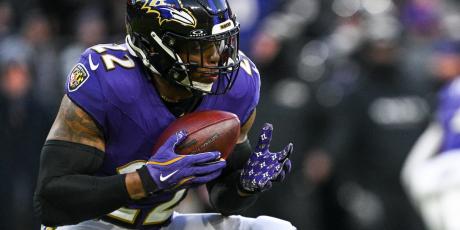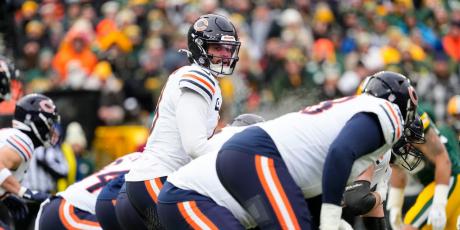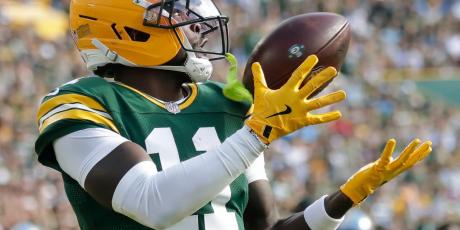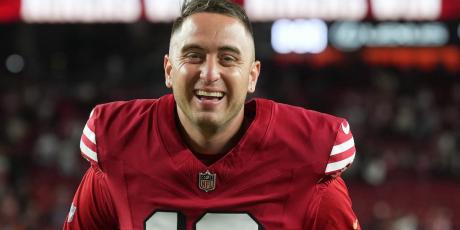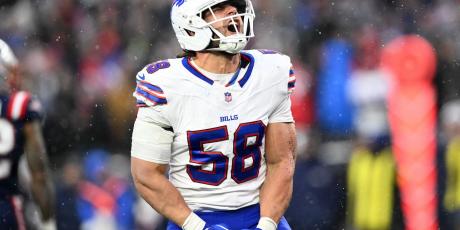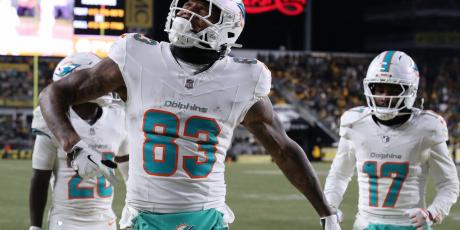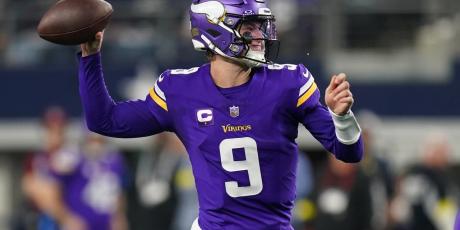11 Running Back Touchdown Regression Candidates

Position players see so few opportunities near the end zone that it can seem nearly impossible to predict how many touchdowns a player will score in a given year. Because touches inside the red zone are relatively low, no matter how heavily used a player is, stats such as touchdown rates can swing wildly from one year to the next. For running backs, predicting red zone production can be especially frustrating since they are compiling touches both on the ground and through the air -- methods of moving the ball that result in very different expectations.
We can use the fact that touchdown rates can be very volatile to our advantage by looking for players that had touchdown rates well above or far below the mean (either the league average mean or an individual mean) if we have a large enough sample for a player. Since all red zone touches aren’t created equally, we can use regression analysis not just for opportunities (rush attempts and targets) inside the 20-yard line, but inside the 10 as well.
Red Zone Expected Value
In my quarterback touchdown regression article, I introduced a metric called Red Zone Expected Value (RZEV). Based on starting field position, every play has a different chance of scoring a touchdown. RZEV calculates the odds of scoring for every play and assigns each player a score that reflects expected points from touchdowns generated by plays inside the red zone.
Calculating RZEV for running backs is a little tricky, though, since rush attempts and targets do not have the same touchdown expectation, and running backs targets do not have the same expectation as a pass to wide receiver or tight end.
The following table lists the expected value for all running back red zone opportunities:
| Rush Attempts | Running Back Targets | |||
|---|---|---|---|---|
| Starting Yard Line | % Chance of a TD | EV of a Rush Attempt | % Chance of a TD | EV of a Target |
| 20-16 | 2.9% | 0.17 | 5.4% | 0.32 |
| 15-11 | 5.4% | 0.33 | 11.3% | 0.68 |
| 10-6 | 13.9% | 0.83 | 22.0% | 1.32 |
| 5-1 | 38.8% | 2.33 | 44.7% | 2.68 |
After compiling every red zone opportunity for every running back in the league from 2015, I calculated each back’s RZEV and compared that number to the actual points that they generated from red zone touchdowns. The differential in those numbers will serve as an indicator for running backs that scored more often or less often than they should have in the red zone based on where each play started.
Negative Touchdown Regression Candidates
League Average Red Zone Touchdown Rate - 15.7% of touches
League Average Touchdown Rate from Inside 10-Yard Line - 27% of touches
Danny Woodhead, Chargers
2015 Red Zone Touchdown Rate - 24.3%; Career - 17.7%
2015 Touchdown Rate Inside 10-Yard Line - 41.2%; Career - 23.1%
RZEV - 33; Actual Points From Red Zone Touchdowns - 54
Woodhead is one of the most consistently undervalued running backs in fantasy football, and last year he proved his worth with a RB3 finish in PPR leagues. While Woody is still a value in 2016, especially with Ken Whisenhunt back as the OC in San Diego, fantasy owners shouldn’t expect a repeat of 2015.
Because Woodhead’s primary role in the red zone is that of a pass catcher, his opportunities are inherently more valuable than most running backs', but even with those valuable targets, the diminutive back found the end zone far more than he probably should have. Woodhead scored at an unsustainable rate inside the red zone in 2015, as no running back scored more points from red zone touchdowns over expectation. Woodhead ranked 21st among backs in RZEV, yet was tied for the fourth-most touchdowns inside the opponent’s 20-yard line.
Woodhead’s price (outside of the top 20 running backs) should still beckon owners on draft day, but he’ll have a hard time scoring on almost a quarter of his red zone opportunities again and returning to the RB1 ranks.
Todd Gurley, Rams
2015 Red Zone Touchdown Rate - 28.1%; League Average - 15.7%
2015 Touchdown Rate Inside 10-Yard Line - 41.2%; League Average - 27%
RZEV - 33.6; Actual Points From Red Zone Touchdowns - 54
There are certain players that have a special knack for finding the end zone, and while the No. 10 overall pick from 2015 may be one of those players, it will be virtually impossible for him to maintain his scoring pace from his rookie season. Gurley scored at a rate almost twice the league average on plays starting inside the red zone, and from inside the 10-yard line he bested the league average scoring rate by 14 percentage points.
Gurley might end up being an above-average scorer, but history proves that his scoring rate will drop. Only four active running backs with at least 50 career red zone opportunities have maintained a red zone touchdown rate over 20 percent. Two of those backs are goal line specialists (Mike Tolbert and Matt Asiata), one is still dealing with a relatively small sample size himself (Jeremy Hill), and the other is arguably the best back of our generation (Jamaal Charles). Even Charles can’t score at the rate that Gurley last year.
Lamar Miller, Texans
2015 Red Zone Touchdown Rate - 30.4%; Career - 17.3%
2015 Touchdown Rate Inside 10-Yard Line - 33.3%; Career - 25.4%
RZEV - 27; Actual Points From Red Zone Touchdowns - 42
No qualifying running back (min. 20 opportunities) scored at a higher rate inside the red zone than Miller, who ranked 26th among all backs in RZEV, but scored the seventh-most red zone touchdowns. Much of Miller’s red zone success can be attributed to the fact that a whopping 65 percent of his red zone opportunities came from inside the 10-yard line, the second-highest percentage of red zone opportunities from inside the 10 for any qualifying back (Matt Forte, 70 percent).
Moving from Miami to Houston, it will be tough for Miller to replicate his volume inside the 10-yard line, since DeAndre Hopkins is a much more formidable target near the end zone than Miami’s main goal line receiver in 2015, Jarvis Landry.
David Johnson, Cardinals
2015 Red Zone Touchdown Rate - 30%; League Average - 15.7%
2015 Touchdown Rate Inside 10-Yard Line - 37.5%; League Average - 27%
RZEV - 34.5; Actual Points From Red Zone Touchdowns - 54
With almost identical red zone numbers to Gurley, Johnson is another rookie that benefited from an astronomically high scoring rate. There were 15 running backs in 2015 with a higher RZEV than Johnson, but only three backs scored more touchdowns from inside the red zone than the Cardinals’ rookie.
Like Gurley, history shows that it will be virtually impossible for Johnson to keep up his scoring pace. While a full season of work as Arizona’s starting back could result in 2016 season-long numbers that look very similar to end-of-season numbers from last year, fantasy owners shouldn’t take Johnson’s body of work from the second half of 2015 and extrapolate those stats over a full 16 games.
Jeremy Hill, Bengals
2015 Red Zone Touchdown Rate - 25%; Career - 22.5%
2015 Touchdown Rate Inside 10-Yard Line - 40%; Career - 35.6%
RZEV - 51.9; Actual Points From Red Zone Touchdowns - 66
Jeremy Hill might be considered a pseudo-goal line specialist, but his 2015 RZEV shows that he was still scoring at a much higher rate than expected. With 11 red zone scores, only six running backs scored further above expectation than Hill did last season.
Cincinnati’s second-year back still has a relatively small sample size, so his career touchdown rates could still very well regress to the league mean. Of Hill’s 17 career red zone touchdowns, 15 have come from inside the 5-yard line, and if he fails to convert even a couple of those touches in 2016, his fantasy numbers could see a precipitous fall.
Positive Touchdown Regression Candidates
Javorius Allen, Ravens
2015 Red Zone Touchdown Rate - 6.3%; League Average - 15.7%
2015 Touchdown Rate Inside 10-Yard Line - 7.1%; League Average - 27%
RZEV - 36.7; Actual Points From Red Zone Touchdowns - 12
Despite the 12th highest RZEV among all running backs in 2015, 45 rushers scored more touchdowns inside the red zone than the two that the man affectionately known as “Buck” mustered. Allen’s 24.7 points below RZEV was the most points below expectation for any running back in the league last season.
Although Justin Forsett is returning, he’s on the wrong side of 30 and might be the worst red zone back in the league. Given Allen’s small sample size, we should expect him to convert at least a marginally higher rate of his red zone touches into scores and possibly be one of the best late-round values in fantasy.
Giovani Bernard, Bengals
2015 Red Zone Touchdown Rate - 5.7%; Career - 12.8%
2015 Touchdown Rate Inside 10-Yard Line - 0%; Career - 18.2%
RZEV - 27.5; Actual Points From Red Zone Touchdowns - 12
While Hill scored well over expectation, his backfield mate, Bernard, found the end zone far less than expected. Gio didn’t score on any of his 15 opportunities inside the 10-yard line, and a third of those looks were from inside the five.
Like with Hill, we are dealing with a relatively small sample size when it comes to Gio, so while he’s been bad in the red zone so far in his career, it’s improbable that he is really as inefficient as he has shown so far. Based on his decent amount of red zone volume, Bernard is likely to find paydirt more often in 2016.
T.J. Yeldon, Jaguars
2015 Red Zone Touchdown Rate - 7.1%; League Average - 15.7%
2015 Touchdown Rate Inside 10-Yard Line - 18.2%; League Average - 27%
RZEV - 25.7; Actual Points From Red Zone Touchdowns - 12
Most analysts point to Jacksonville’s passing volume in the red zone as one of the reasons that T.J. Yeldon’s fantasy stats suffered in 2015, but the fact is that Yeldon’s RZEV was on par with Lamar Miller and not far behind Danny Woodhead.
Yeldon’s inability to convert short yardage situations is an apparent rationale for the Jaguars’ acquisition of Chris Ivory, but Ivory is bad in short-yardage situations in his own right. For his career, Ivory has converted just 33 percent of his rushes inside the 5-yard line into touchdowns, five percentage points below the league average and third-worst among active backs with at least 30 such attempts.
If (when) Ivory doesn’t solve the Jags goal line woes on the ground, Yeldon will get another crack at it and will assuredly score at a higher rate than he did last season.
Matt Jones, Redskins
2015 Red Zone Touchdown Rate - 7.1%; League Average - 15.7%
2015 Touchdown Rate Inside 10-Yard Line - 14.3%; League Average - 27%
RZEV - 25.3; Actual Points From Red Zone Touchdowns - 12
If Gurley and Johnson were the good rookie twins from last year, then Jones and Yeldon were the evil version. Jones’ red zone numbers mirrored Yeldon’s almost exactly, but unlike Yeldon, Washington got rid of Jones’s goal line competition, rather than bringing in someone else.
Washington is a dark horse to have one of the best passing offenses in the league, and a good passing offense is an efficient offense, which means more scoring opportunities for Jones. An increase in red zone work coupled with touchdown rates closer to the league average could make the Redskins’ sophomore back a splendid value in fantasy drafts.
Isaiah Crowell & Duke Johnson, Browns
2015 Combined Red Zone Touchdown Rate - 9.8%; League Average - 15.7%
2015 Combined Touchdown Rate Inside 10-Yard Line - 13%; League Average - 27%
Combined RZEV - 47; Actual Points From Red Zone Touchdowns - 30
Crowell and Johnson combined for 51 red zone opportunities, but converted just five of those chances into scores. Together, the Cleveland running back duo scored the fourth most red zone points below expectation last year.
Although Crowell’s individual red zone touchdowns matched his RZEV almost perfectly, his 12.5 percent red zone touchdown rate was the furthest below career average of any qualifying back last season. Johnson's sample size was very small, but the rookie converted just one of his 19 red zone opportunities into a touchdown.
New HC Hue Jackson has a history of giving two running backs a significant workload. With a running back-friendly coach and positive touchdown regression on the horizon, the Browns’ backfield is in a position to see a significant jump in touchdown totals.
Still not a subscriber? Sign up here!
Related Articles
- Introducing Red Zone Expected Value & 7 Quarterback Touchdown Regression Candidates
- Yes, You Should be Using Zero RB in 2016
- 22 Running Back Sleepers & Values (Plus 15 Attrition Plays)
- Game Script Sensitivity and an Intro To Win-Adjusted Rush Rates
- Oakland Has One of the Most Valuable Backfield Situations in Fantasy
- Using Advanced Stats to Identify 7 Breakout Running Backs
- Woodhead Has RB1 Upside Again in 2016

